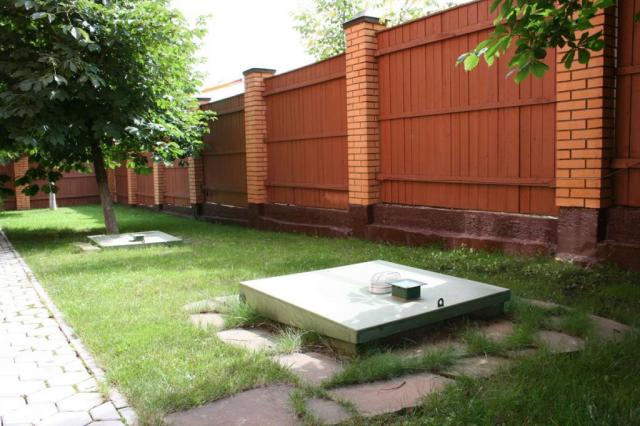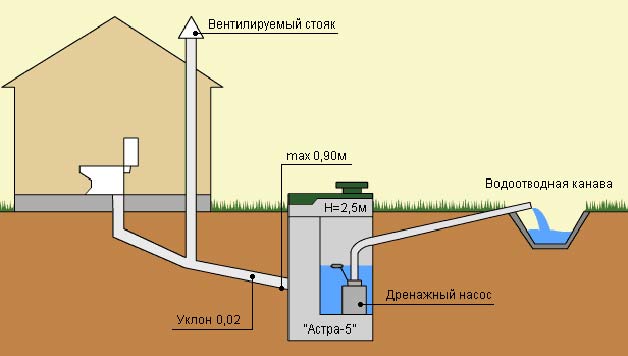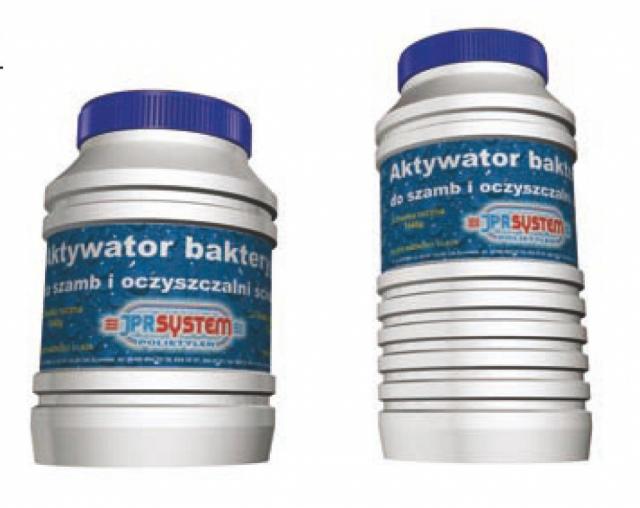Cesspool cleaning
When designing a country or country house, it is necessary to immediately take into account the arrangement of the drainage system. The best solution to this issue today would be a cesspool. To implement your plans, you need to study specific recommendations, tips and established regulations on the topic of a cesspool - sanitary standards.
The design and arrangement of an autonomous sewage system for a private household is associated with compliance with sanitary requirements, certain norms and rules that are mandatory. In case of violation of the points of sanitary standards during the design and construction of a cesspool, its operation can then bring many problems and considerable fines.
Failure to comply with the requirements of even a part of the established rules leads to pollution of natural sources of drinking water and the spread of infections. Therefore, the ideal option before building a cesspool would be to include it in the development plan and coordinate with all government services involved in this issue, including SES. This is necessary to obtain building permits.
How to choose the right construction site?
The cesspool is a container for the accumulation of domestic wastewater. To determine its location and harmonize with the regulations of sanitary standards, it is necessary to analyze your site and the surrounding area.
To do this, you need to study the schematic plan of the site, where the location is indicated:
- residential building;
- outbuildings;
- wells;
- gas pipelines;
- water pipelines.
Here it is necessary to take into account the elements of the landscape, lowlands and highlands. When planning, the location of neighboring houses, wells and communication systems in nearby areas should be noted in order to allocate areas for a “sanitary zone”. When planning the location of the cesspool, it is necessary to take into account the direction of movement of groundwater. Information about them can be obtained from the relevant services.
Conditions and standards for choosing the location of the pit
After analyzing the schematic plan, it is necessary to choose the optimal place for the cesspool. According to sanitary requirements, it must be removed:
- From the neighboring house and its facilities - 10-12 meters.
- The boundaries of the site - not less than 1.5 meters.
- Residential building - at a distance of 8 to 10 meters.
- Water intake wells - 20 meters.
- Water pipes - 25 meters.
- Underground groundwater flows - at 25 meters.
- Gas pipes - 5 meters.
When building a cesspool, the condition of the soil at the location of the device must be taken into account. On clay soils, according to sanitary requirements, natural wells should be located at a distance of 20 meters from the pit. On loamy soils, they move away by 30, and on sandy or supersandy soils by 50 meters.
What type of cesspool to choose
Important Ingredients
The simplest option provided by SNiP is a bottomless cesspool. It is designed for small waste emissions up to 1 cubic meter per day. During this time, the effluents have time to pass naturally into the ground, and the aerobic soil bacteria process them.
Accumulated sludge from such cesspools should be removed periodically - once every six months. However, this is the easiest and most affordable option for receiving and disposing of wastewater. It belongs to the type of village toilets, which are no longer relevant today due to their low resource for receiving wastewater and unpleasant odors around it. In addition, such structures today can be environmentally hazardous.
If more than two people live in the house, accustomed to the comfortable conditions of urban life, it is necessary to consider options for arranging sealed cesspools. They are environmentally friendly, and waste from them will not fall into the soil. One option that meets the requirements of SNiP is a pit made of concrete, cinder block or brick. An excellent solution to the issue of discharging domestic wastewater would be a sealed storage septic tank made of plastic.
Pit requirements
The depth of the sealed pit must be made no more than 3 meters. This is due to its maintenance by a sewage truck, the hose of which is designed for a 3-meter length of sewage intake. If you make the hole deeper, the cleaning efficiency will decrease due to the constantly remaining sediment at the bottom.
The sewer pipe entering the pit should be 10 cm in diameter. The depth of its laying in the ground is 1.2 m, which ensures its safety in winter. The slope of the pipe towards the drain pit must be at least 3%.

sewer manhole
The entrance of the sewer pipe into the wall of any constructive solution of the pit must be made soft. For these works, bitumen and ordinary building foam are excellent.
The bottom of the pit is equipped with a mandatory slope towards the hatch, which will ensure better pumping of sewage. To exclude the possibility of an explosion in the pit, it is necessary to install a ventilation pipe with a diameter of 10 cm and bring it above the ground to a height of at least 60 cm.
The decomposition of organics in the pit results in the formation of methane gas, which often causes an explosion. Therefore, it must be removed from the internal volume of the sealed pit.
For the operation of the sewage truck and maintenance of the pit, it is necessary to provide an accessible entrance to it. It will be necessary to call the car 2 times a month at a consumption of more than 150 liters of water per day per person.
Types and design of autonomous sewer systems
Sewers for autonomous use are divided into:
- For non-volatile. In this case, the drains flow into the pit naturally.
- Volatile - at the same time, a pump is required to pump out effluents.
The main condition for arranging an autonomous wastewater storage tank is the complete tightness of the structure. Installation of ready-made septic tanks on the site provides absolute sealing, which is guaranteed by the manufacturer.
A cesspool can be designed and constructed from a variety of materials, including brick, cinder blocks, or prefabricated concrete blocks and rings.
Features of brick and cinder block pits

Scheme of the sewer system
The construction of a brick or cinder block pit takes a lot of time and labor, but it ensures full compliance with the requirements of SNiP.
The main stages of construction work:
- The walls of the pit are laid out with bricks or cinder blocks with mandatory dressing of the seams.
- The inner surface is plastered and ironed.
- The outer perimeter of the masonry is smeared with a 20-cm layer of greasy clay.
- The bottom of the pit is also first smeared with a layer of the same greasy clay, and then concreted from above, followed by ironing the base of the cesspool.
Construction of a cesspool from blocks and rings
The use of reinforced concrete rings and ready-made concrete blocks for the construction of a cesspool has several advantages, but requires special handling equipment for their installation. For the construction of a cesspool, it is necessary to have a cover, a bottom and at least 3 rings.
After excavation and cleaning the base of the pit, the bottom must be concreted. Then you need to finally check all the dimensions according to the project in order to carry out a successful installation of the rings. After installing the rings, their inner surface is covered with bitumen, having previously sealed the joints with concrete. Similar work is carried out at the bottom of the pit.
When constructing a cesspool made of reinforced concrete or concrete products, special attention is paid to waterproofing so that during operation the pit is not filled with melt or rainwater.
After connecting the sewer pipes, a hatch is mounted and the structure is covered with earth.
Conclusion

Biological product for cleaning cesspools
Recently, ready-made projects for autonomous cleaning systems have been developed. All of them are volatile and expensive, but at the output the customer receives a complete and complete "turnkey" system of modern biological treatment.
Air and reagents are injected into these systems, and harmful wastewater substances after biological treatment become harmless. Today it is the most effective method of wastewater treatment, providing for water purification up to 98%. Special permission from the sanitary services for such systems is not required.
Similar posts


















